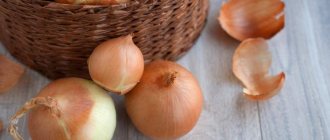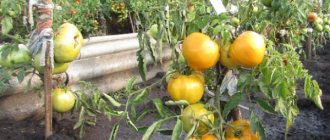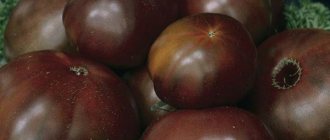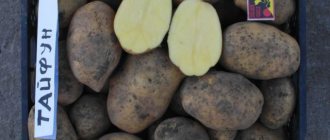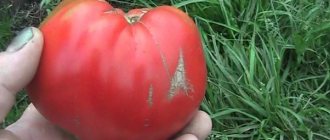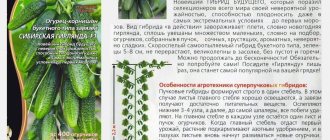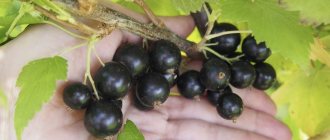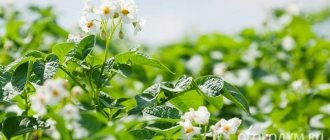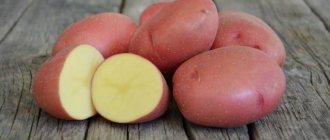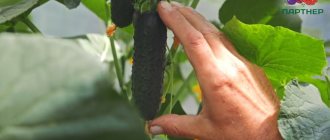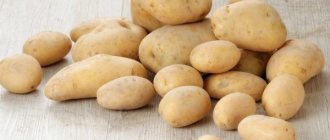Description of the variety
The exquisite taste and unique properties have made Red Baron famous throughout our country. Experts say that red varieties of onions, unlike light ones, contain several times more antioxidants ; they more actively help the body fight infections, resist aging and cancer.
Origin and development
Red Baron onions are a variety bred by Dutch breeders for cultivation in different climatic zones . It thrives both in warm climates and in regions with cold weather conditions.
Chemical composition and beneficial properties
The chemical composition of the red vegetable is characterized by a high content of ascorbic acid and sugars; it contains many flavonoids, which help the proper functioning of the body and increase resistance to many diseases.
Useful properties of the Red Baron variety:
- Onion gruel relieves spasms and inflammation, swelling and pain, and helps with muscle strain.
- Doctors often recommend this variety to people with diabetes mellitus and excessive salt deposits. Onion broth removes water from the body well.
- Regular consumption of red onions slows down or prevents cancer processes.
- Used as a dietary product to reduce weight.
- Improves heart function, relieves stress, is useful for the prevention of atherosclerosis, and reduces cholesterol levels.
- Grated onion effectively gets rid of warts.
- Increases stomach acidity, recommended for gastritis with low acidity.
Red Baron onions have the most useful upper juicy scales - they contain the most useful substances and microelements.
Ripening period
Red Baron is considered a mid-early variety . Harvesting begins approximately in the second half of July, when 80-100 days have passed since germination.
Productivity
It has high productivity. When sowing seeds from 1 sq. m harvest up to 3 kg of onions , and from 500 g of sets an average of 10-15 kg of large red heads comes out.
Disease resistance
Red Baron has increased resistance to fusarium, downy mildew and root rot with good soil drainage and regular loosening.
Characteristics of the bulb, description of appearance, taste
If you look closely at the bulbs of the Red Baron variety, you will notice that they are more likely not red, but purple with a reddish tint. The inner scales are juicy and dark red.
Characteristic features include the following:
- The shape of the bulb is round, slightly flattened at both ends;
- leaves are dark green, with a faint waxy coating;
- the scales are difficult to separate and fit tightly to the bulbs, which facilitates long-term storage;
- powerful root system, capable of growing even in dry weather;
- the average weight of one vegetable is 60-150 g, with proper care it reaches 200 g;
- the taste is slightly spicy, pleasant, without bitterness.
For which regions is it best suited, climate requirements?
The variety is almost universal in its growing region . It is recommended to grow it in the Central Black Earth and Central regions; it is suitable for the Volga-Vyatka District and the North Caucasus; it will be possible to grow an excellent harvest in the Ural climate and in the North-West of Russia.
Not tied to a particular climate. Cold-resistant, but does not tolerate frost . In open ground it will withstand temperature drops down to +2°C.
In hot weather, when the thermometer shows above +30°C, it needs abundant watering.
Fruit characteristics
- The color is red-violet inside and out.
- With proper care, the bulb can grow up to 200 g. However, on average its weight is 100-150 g.
- The shape is round, flattened on both sides.
- The scales fit tightly to the bulb.
- The feathers are dark green with a waxy coating.
- The taste of onion is mildly spicy, without bitterness.
- Contains a lot of dry matter, ascorbic acid and antioxidants, vitamin C.
- Has long shelf life. When stored in a cool, dry place it will last until summer.
The main advantages and disadvantages of the variety
The variety has more advantages than disadvantages.
Among the advantages:
- Precocity. The harvest will be high even in areas with cold climates, without loss of taste.
- Rich color that does not disappear during long-term storage and does not stain other products when preparing a dish.
- High-quality ripening after harvesting, attractive presentation.
- Long-term storage, subject to the necessary conditions, does not lose its quality until June.
- Resistance to a number of diseases and pest attacks.
- Unpretentiousness to soil and climatic conditions.
- High transportability.
Minuses
Experienced vegetable growers consider the downside of this variety to be growing onions primarily by seeds rather than by planting sets. It is quite problematic to buy good quality Red Baron varieties without mis-grading.
What is the difference from other varieties
The red onion variety Red Baron, in addition to color, has a number of other characteristic distinctive features :
- Red Baron does not have the bitter taste characteristic of yellow and some white varieties of onions.
- When cooked, it does not turn the skin of your hands or vegetables in salad red.
- Dessert varieties, to which Red Baron belongs, do not take root well in the northern regions, and even if they produce a harvest, they lose their taste and color. Red Baron grows excellently in cold climates and retains all its unique properties.
- Contains a greater amount of dry matter, antioxidants and ascorbic acid compared to other varieties.
Preparing and planting onion seeds
In some regions, for example, in the south of Ukraine, in Moldova, large bulbs can be obtained during sowing in the first year. In colder climates, the seeds provide material for planting the following year.
Before planting, Red Baron onion seeds need to be properly prepared:
- The seeds are hardened, they are placed in hot water (50-60°C) for a few minutes, then immediately transferred to the refrigerator for a day.
- The seed is soaked for an hour in a slightly pink solution of potassium permanganate.
- To a glass of water add 2-3 drops of the stimulant Epin or 0.5 tsp. honey mixed with aloe juice, soak the seeds in the solution for 18 hours.
- Before planting, the seeds are slightly dried.
The Red Baron variety of red onion should be sown in the ground at the end of April or beginning of May, when the frosts have passed. It is important not to miss the deadline, since at the end of August it will get colder, it will rain, and the bulbs may rot. Sow onions like this:
- Dig grooves 1.5 cm deep in the garden bed.
- The distance between them is 15 cm.
- Water the beds with warm water.
- The seeds are deepened into the ground by 1-1.5 cm; there should be a distance between them equal to the sowing depth.
To make the seeds visible, the bottom of the grooves can be sprinkled with light sand. After planting is completed, the grooves are sprinkled with a thin layer of earth. You can cover them with foam on top so that shoots appear earlier. On average, Red Baron onions germinate from seeds in 2-3 weeks.
Features of planting and growing
Red Baron onions can be grown from seeds or using sets . Let's consider both options.
Preparing for landing
Before sowing, it is recommended to immerse onion seeds in a warm, weak solution of potassium permanganate for twenty minutes . Then put it in a damp piece of gauze and put it in a warm place for several days. Some gardeners use the growth stimulator "Epin". The seeds are sprayed with it just before sowing.
Before planting, the dry upper tail of small bulbs is cut off , trying not to touch the so-called growth point, after which they are soaked in warm water with potassium permanganate for 12 hours. If you didn’t have time to do this, then dip it in a solution of copper sulfate for 8 minutes.
Soil requirements
The best harvest of Red Baron onions is obtained on clay-sandy, loose, light soil . But loamy and acidic soil is best avoided.
It is necessary to prepare the ground for planting onions in the fall . To do this, choose a dry, well-lit place, dig it up, adding humus or compost at the rate of 3 kg of fertilizer per 1 square meter. m. According to the rules of crop rotation, onions need to be planted in the same place where tomatoes, cucumbers or cabbage grew.
In the spring, the area is carefully weeded and, if necessary, dug up again with a glass of wood ash per 1 square meter. m. This should be done two weeks before planting seeds or sowing.
Dates, scheme and rules of planting
Onion seeds are sown in the first half of April in grooves 3-4 cm deep, evenly distributed and watered with warm water. Then sprinkle with earth and lightly compact. The distance between the rows is left approximately 5-7 cm.
The bulbs are planted in the ground at the end of April , the depth of the hole should be 6-7 cm, the row spacing should be wider - 14 cm, the distance of the heads from each other is on average 10 cm. The bulbs should be lowered into the hole so that one fourth of the head sticks out of the ground.
Important! If you want the onions to have large, juicy feathers, fertilize the ground with potassium nitrate before planting. If you want strong, large bulbs, add superphosphate. Use one or the other at the rate of 1 tbsp. l. per 1 sq. m.
Features of cultivation
Any vegetable crop requires mandatory care. Red Baron onion is no exception; after planting it will need :
- Regular weeding is mandatory so that the still unformed root system of the planted seeds is not clogged with weeds.
- As soon as the seeds germinate and rise a couple of centimeters, the first thinning is carried out. This is done as needed so that ultimately the shoots are spaced 10 cm apart from each other. There is no need to thin out the planted seedlings.
- Abundant watering is necessary for both seeds and small bulbs as they grow and develop.
Nuances of care
Red Baron is unpretentious in care, but there are three main points, without which this onion will not give a rich harvest : weeding, watering and loosening the soil - that's all you need to know about the nuances of caring for a red vegetable.
Watering mode
Red Baron needs abundant watering most of all in the first half of the growing season and in dry weather , and 15 days before harvest it stops watering. Plants are watered at least once a week - 10-12 liters of water per 1 square meter. m.
Loosening the soil and weeding
Another mandatory point in caring for Red Baron onions is loosening the soil. It must be done after watering or rain , so that a dense crust does not form on the soil, interfering with the breathing of the root system.
Timely destruction of weeds will not only enable onions to grow and develop better, but will also protect them and other vegetable crops in the garden from a number of pests. Many parasites settle and rest after a “meal” on weeds.
Top dressing
Growing Red Baron onions also includes timely feeding. This must be done at least three times per season . The first fertilizing is carried out two weeks after planting seeds or planting seedlings in the soil.
Water with mullein solution, diluting it with water in a ratio of 1:15 or superphosphate - 1 tbsp. l. on a bucket of water. The following fertilizing is done once every two weeks - potassium sulfate is added: 1.5 tbsp. l. on a bucket of water.
Important! In order not to harm the root crop, fertilizing should not be carried out later than mid-July.
Disease and pest control
Red Baron is resistant to a number of diseases, but is sometimes attacked by bulb flies. The parasites lay eggs on the leaves of the onion, the hatched larvae feed on the juices of the plant, after 10 days the onion begins to lag in growth and wither. As a result of the attack, the crop shortfall will be about 30%.
Pest control measures are::
- compliance with crop rotation - you cannot plant onions in last year’s place where carrots grew;
- weed control;
- After watering the onions, wood ash is scattered in a thin layer between the beds and over the plants;
- chemical treatment with Karate Zeon and BI-58N.
Care
Let's look at the main points for caring for Red Baron onions.
After the sprouts appear, the film must be removed from the garden bed, otherwise the seedlings will be too hot. To ensure the protection of seedlings from night cold snaps, the film can be replaced with spunbond.
Until the onion has three or four feathers, it is very vulnerable to various harmful insects. The roots of the plant are especially affected. To protect your vegetable crop and protect it from pests, carefully weed the weeds in the garden bed. In addition, you can treat the soil with a special protective mixture. It will also be useful to know about which plants you can plant onions after.
Video shows how to care for onions:
This mixture consists of:
- wood ash;
- naphthalene;
- river sand.
The first two components are taken in the amount of one part, and sand - 20 parts. Everything is mixed and then poured in a thin layer onto the surface of the soil. This composition is able to protect the crop from attack by onion flies.
In order for the seedlings to be strong and healthy, the seedlings need to be thinned out: as you remember, it was recommended to plant more seeds. Remove weaker shoots, leaving strong and tall ones. If the seedlings have one feather, leave a distance of one and a half centimeters between the bushes. If 2-3 feathers have grown, the distance must be expanded to 3 cm. With the appearance of the fourth feather, increase the distance to 6 cm - and this is the final distance at which the onions will ripen for the rest of the time. A shorter distance is unacceptable, since in this case the bulbs will not be able to grow stronger and will remain small and underdeveloped. It is unlikely that they will produce a good harvest next year. This video will help you understand how Carmen ms onions are grown from seeds.
Red Baron onions definitely require regular watering. And after each watering and rain, it is also necessary to loosen the soil, providing it with good air permeability. There is no need to go deep when loosening: a depth of 3 cm is sufficient. Carry out the procedure carefully, since onions have a superficial root system.
As for watering, during the first month of life, the seedlings need to be watered 1-2 times a week using a sprayer or watering can with very small holes. In mid-July, watering must be stopped, as the bulbs begin to ripen, and it is necessary for this process to take place fully.
The plant needs feeding. So, when the Red Baron onion has three feathers, it is necessary to add mullein to the soil at the rate of 1 part fertilizer to 15 parts water. Add 1 tbsp superphosphate to the nutrient solution. spoons into a 10-liter bucket. Instead of mullein, you can also use chicken manure, which onions also love.
After this first feeding, the further fertilization procedure must be carried out once every 2-3 weeks with the following solution: in a ten-liter bucket, you need to dilute one and a half teaspoons of potassium sulfate, and add a tablespoon of superphosphate. Before adding the nutrient mixture, first water the bed a little with plain water.
It is also worth paying attention to how the Yalta onion is grown
Harvest and storage
As soon as the feathers completely turn yellow and fall off, they begin harvesting . The bulbs are taken out of the ground and dried.
How and when to collect
Harvesting of Red Baron onions begins around mid-August . To keep it better, it is collected in dry weather. You need to dig out the onion with a pitchfork, and not pull it out by the feathers, which will damage the integrity of the vegetable and make it unsuitable for storage.
then laid out under a canopy and dried for ten days . After the outer husk of the vegetable has dried, the roots and feathers are carefully cut off. Then dry again in a dry room for two weeks.
When the top husk is completely dry, the onion can be stored. It is placed in nets, bags or tied into convenient “braids”.
Storage features and keeping quality of the variety
The red onion variety Red Baron has excellent shelf life and, in the right conditions, can retain all its qualities until the beginning of summer.
It is important that all bulbs collected for storage are dry and healthy . To make sure of this, perform a sort. Place the largest, driest and hardest onions in one bag, the smaller ones in the next, and so on.
Attention! To prevent onions from going into arrows, the bulbs must be stored at a temperature of 0 to 5°C.
The storage room should be cool and dry , and bags of vegetables should not be on the floor. Place a thick layer of cardboard or wooden boards under them.
Planting onion sets
In most regions, it is more convenient to propagate the red onion variety from sets: this way you can get a juicy green feather in May, and by August you can get large, dense onions. In order for the harvest to be good, you need to properly prepare the planting material. They do it like this:
- 3-4 days before planting, trim the tips so that the feathers grow better.
- Soak the bulbs for 12-15 hours in water at a temperature of 35-38°C.
- If desired, before planting, soak the seeds for 30-60 minutes in a light pink solution of potassium permanganate.
- At the end, the onions are thoroughly dried.
Red Baron onion sets are best planted in the ground when the outside temperature is 10-15°C. If it is higher, the fruits will not be as juicy and bitter. When a plant is planted ahead of schedule, it produces a lot of green mass, but the bulb remains small.
The distance between the rows in the garden bed should be about 20 cm. The onions are immersed in the soil by 3-4 cm, the distance between them is 8-10 cm. After the onions are planted in the garden bed, they are sprinkled with soil and watered.
What difficulties may there be when growing
The main difficulty in growing Red Baron onions , according to experienced gardeners, is finding high-quality sets in the store. Therefore, many people grow it themselves.
Otherwise, this variety is unpretentious and easy to grow; even beginners can cope with it.
Growing methods
This variety can be grown in several ways:
- using seedlings;
- sowing seeds in open ground;
- onion set.
Each option has its own characteristics, advantages and disadvantages. But first things first.
From seeds (seedlings)
Instructions on how to grow onions from seeds in one year through seedlings are as follows:
- Seed preparation. Do not use seeds older than two years - they will not sprout. Planting material requires additional protection from diseases. It is enough to place them in a pink solution of potassium permanganate for 5-10 minutes, dry them, and soak them in a growth stimulator.
- Tara. A good option would be long wooden boxes or purchased cassette containers.
- Priming. To obtain healthy and strong seedlings, it is better to buy special soil. It contains all the necessary minerals and components.
- Landing. Sowing should be done at the end of February or beginning of March.
- Lightly moisten the soil, make grooves, and place the seeds in them. The distance between rows should be 5 cm, between seeds - 3 cm.
- Then pour a thin layer of earth on top, lightly spray with water, cover with polyethylene and place in a warm place.
- Temperature conditions. The optimal room temperature is +20-+24°C.
Onions do not require frequent watering, so water procedures are carried out as needed.
Conditions for planting in open ground: mid-May, seedlings reached a height of 15 cm, 3-4 feathers appeared. Advantages of the seedling method:
- early harvest;
- there is no risk of bulb infection;
- the opportunity to get fresh herbs at home on the windowsill;
- plants do not require special care.
Disadvantages: When planting, you need to pay special attention to the depth of seed placement. If they are deepened too much, there will be a delay in formation and you may lose the harvest.
Important! When planting seedlings in open ground, it is necessary to follow the scheme: place each plant in its own hole, maintaining a distance between rows of 30 cm, between bulbs - 5 cm
After planting, be sure to water and mulch the ridge with peat.
Important! When planting seedlings in open ground, it is necessary to follow the scheme: place each plant in its own hole, maintaining a distance between rows of 30 cm, between bulbs - 5 cm. After planting, be sure to water and mulch the ridge with peat
Planting sets
These are small oval-shaped bulbs. Each copy has several small roots. It is better to plant seedlings in the spring according to the following instructions:
- Choosing a location. The area should be sunny and well-dried. Recommended predecessors:
- Solanaceae.
Legumes.
- Cucumbers.
- Site preparation. The work is being carried out in the fall.
- Dig up the soil with half a shovel and loosen it well.
- Apply fertilizers in the form of rotted manure (0.5 buckets per 1 square meter of soil), peat (2 buckets), superphosphate (1 tablespoon). You can supplement the composition with 1 cup of wood ash.
- In spring, sprinkle the area with ammonium nitrate strictly according to the manufacturer's instructions.
- Landing:
- First of all, pour boiling water over the ridge to destroy pathogenic fungi and insect larvae.
- Arrange the holes so that the distance between them is 15-20 cm.
- Lightly compact the soil and cover with a thin layer of peat.
- Care. Bow requires:
- Weeding.
- Loosening.
- Polivov.
- Feeding.
It is better to choose an elevated place, otherwise groundwater will wash away all the plantings.
The advantage of this method is that it saves time during the planting process. There is no need to grow seedlings here. It is enough to deepen the seedlings and expect to receive the first greenery. Disadvantages - careful selection of the site, the introduction of a huge amount of fertilizing, the risk of insects and diseases.
How to sow seeds in open ground?
Here the planting process, as well as the advantages and disadvantages, are no different from the previous method. But the time for sowing seeds is in the first half of April.
- Make furrows 4 cm deep on the ridge and water them with hot water.
- Then sprinkle with soil and compact lightly. Maintain a distance between rows of 7 cm.
To achieve the appearance of large and juicy feathers, before planting, you should add 1 tbsp of potassium nitrate to the soil. l. per 1 sq. m plot. If the goal is to form strong and large bulbs, then add superphosphate - 1 tbsp. l. per 1 sq. m.
Growing a feather in one season
To obtain fresh, juicy and healthy feathers, you can choose any of the above methods. But here it is necessary to follow the regime of fertilizing and watering, and cut the greens in a timely manner. The disadvantage of growing onions is the regular pest control. If you are careless about their appearance, you can end up with yellow, dried feathers instead of green ones.
Advice from experienced gardeners
Take a few tips from experienced gardeners:
- When pulling out weeds when weeding, try to prevent them from pulling tiny onion seedlings with them.
- Water the young plants carefully, not directing the stream directly at the vegetable, but trying to use a watering can with small holes.
- Don't overuse chemicals. It is advisable to spray plants with chemicals only when all other means no longer work.
- When planting seedlings, do not skimp on land. If the bulbs are planted frequently, they will not allow each other to grow and the harvest will be weak.
- When drying already harvested onions, do not leave them in direct sunlight - this will damage the bulbs. You will need a canopy.
Diseases and pests
The main enemy of plantings is the onion fly. The larvae can destroy the entire crop. Therefore, it is important to destroy them. The activities are:
- In soil disinfection using ash or a mixture of sand and naphthalene (mixture ratio 20:1).
- Timely weeding of beds.
- Treating plants with insecticides - Aktara, Fly-eater and so on. But it is not recommended to use the feather after spraying.
Powdery mildew is a common disease. A fluffy gray coating appears on the plants. Here it is necessary to treat the bed with a 1% solution of boric acid. After 4 feathers appear, spray the plantings with Rodomil.
Reviews of the Red Baron onion variety
Reviews about the Red Baron red onion variety are mostly positive.
Ilya, Naryan-Mar : “I tried for a long time to grow onions in the Arctic conditions. Nothing worked. Last year I bought a set of the Red Baron variety. I planted it in early June. The onions did not shoot, despite the summer frosts, and for three months they pleased us with dense, green feathers and large bulbs. Baron's keeping quality is satisfactory. The spiciness is a little lower than usual, but the taste is pleasant.”
Elena, St. Petersburg : “I grew a small bed of Red Baron red onions. Excellent quality, good germination. The bulbs are strong, beautiful, incredibly tasty even raw in a salad. I lay there all winter. I will definitely plant it again this year. I recommend!".
Reviews
- Excellent variety. I love. During cultivation, it responds well to fertilizing. Red Baron bulbs have a beautiful appearance and wonderful taste. Over the entire period of growing in my garden, I have always managed to grow a fairly good harvest. On average, over the years I get 3-3.5 kg. bulbs from 1 m2. The harvested crop can be stored without problems for 4-5 months. In a word, I'm pleased with the variety. I recommend that all gardeners try to grow the Red Baron variety. You will be satisfied.
- I like to grow all kinds of exotic varieties in my garden. This rather unusual variety is Red Baron. This variety has a very beautiful appearance. The bulbs are quite large with a pleasant piquant aroma. I really like the fact that during cultivation the bulbs of this variety were practically not affected by diseases. For long-term storage, the variety requires careful drying of the harvested crop. The maximum yield in my garden was 3 kg. from 1 m2. I use the harvested crops to make salads. Good variety. I recommend.
- I have been growing the Red Baron variety for two years now. During cultivation, the bulbs tolerate dry periods quite well and practically do not get sick. The harvest is 3-3.5 kg. I received 1 m2 of bulbs last year. The grown bulbs have a beautiful appearance. Quite large. The mass of the bulb reaches 150 g. I really like the taste of the variety. I use it in canning and various salads. It turns out very tasty. The variety is stored quite well. I'm satisfied with the variety. Just what you need.
- Excellent variety. Over the past few years, I have always grown this particular variety in my garden plot. This is due to the fact that the Red Baron variety grows well even on not very fertile soil. During dry periods it is not suppressed and responds well to the application of organic and mineral fertilizers. The keeping quality of the variety is quite good. The main thing is to properly and carefully refine the harvest. As an ingredient for culinary dishes, the Red Baron variety is simply a fairy tale. Very good variety. I collect about 3 kg of onions from 1 m2. The variety may not be super productive, but it has a divine taste. I recommend this variety to all gardeners. I think he's excellent.
Description of the process of preparing a site for planting
In order to get a good and rich harvest of Red Baron onions, you need to prepare in advance the bed in which it will be grown. You need to choose a bed in elevated areas in order to avoid the accumulation of groundwater, which can destroy the roots of the plant and destroy the future harvest. In addition, raised beds will be able to warm up faster, which affects the speed of crop ripening.
Before planting, in the spring, you need to fertilize the soil of the bed with ammonium nitrate, where you will need one teaspoon of fertilizer per square meter. After this, the soil needs to be loosened, but not deeper than ten centimeters. After which the earth is lightly trampled, watered with warm water and covered with polyethylene. In this state, the bed should be left for two to three days, and after which you can begin planting seed material, which should also be prepared in advance.

